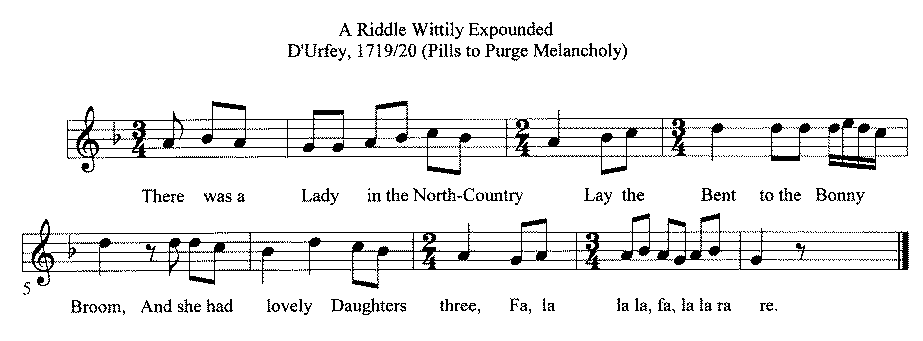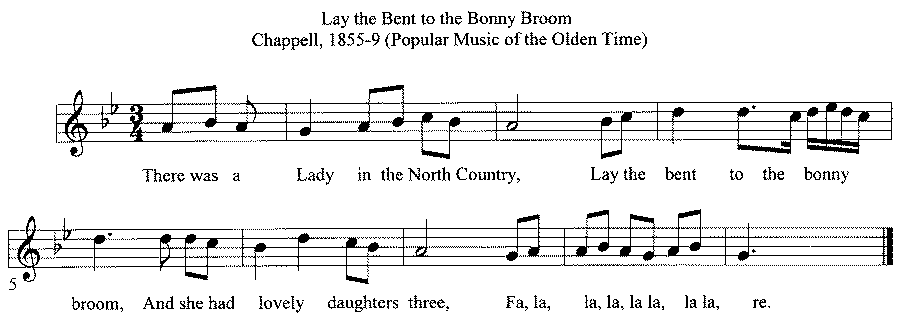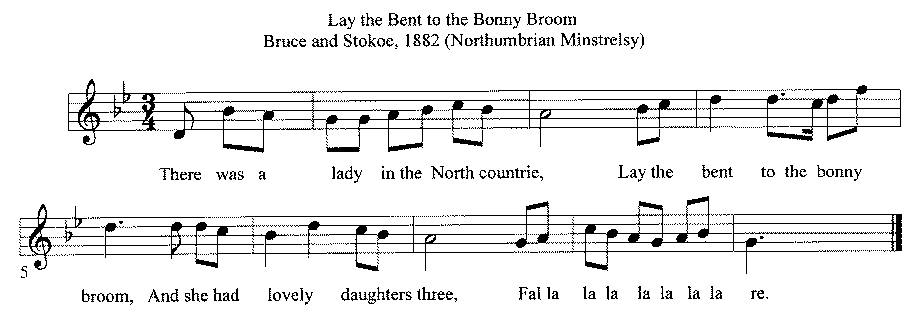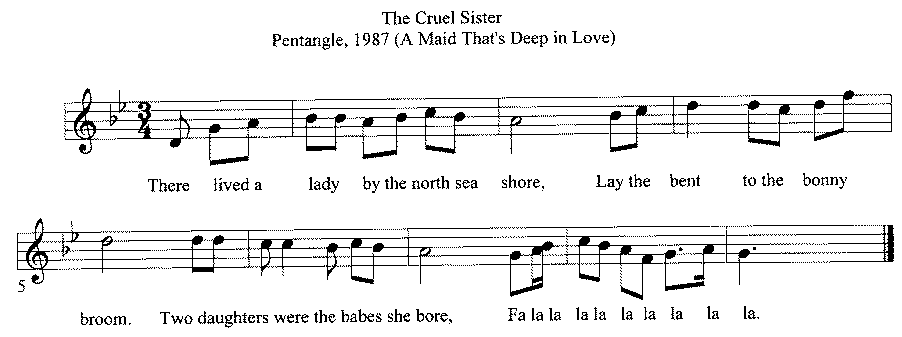
The four melodies for "Riddles Wisely Expounded" (Child #1) which follow are successive versions of the same tune. Indeed, the first three all purport to be transcriptions of the same source.




The four melodies given above are meant, among things, to make my warnings about modern sources more concrete: If you learn a ballad from a modern source, without checking against the original, you are probably learning a modern interpretation of the ballad. The top melody is taken from D'Urfey's 1719/20 "Pills to Purge Melancholy". To be more precise, it is a modernized transcription of D'Urfey, from Bronson's "The Singing Tradition of Child's Popular Ballads". D'Urfey, rather than fuss with multiple time signatures, notated the music in throughout. Bronson is meticulous in annotating such changes, but most transcribers are not.
The second melody is Chappell's transcription of D'Urfey. Emphasis on `transcription': This is the music that Chappell reported D'Urfey as having provided. In fact, as is more common in secondary sources than we could wish, Chappell was reporting what he thought D'Urfey should have meant. The key has been changed from G-Dorian to G-minor, the time signature has been regularized (with some effort) to 3/4, and there is a minor note change. (Chappell also adds piano accompaniment and dynamics.)
The third melody is taken from Bruce and Stokoe, who also claim to be relaying D'Urfey's melody. Like Chappell, they notate the music in G-minor (though, since their version has no E's, this now becomes a distinction without a difference), and they regularize the rhythm (differently from Chappell) to 3/4 time. They also modify the notes in a number of places. The modifications to the melody bring it somewhat closer to modern tastes, and most modern recordings of this melody are closer to Bruce and Stokoe than they are to D'Urfey.
The fourth melody is transcribed from a modern recording - the "Pentangle" recording of "The Cruel Sister". (The opening verses of this version of "The Cruel Sister" (Child #10), and "Riddles Wisely Expounded" are identical, and both are frequently sung to "Lay the Bent to the Bonny Broom".) Although there is a sense in which this melody is "the same tune" as D'Urfey's, it becomes difficult to make a case for this melody line being appropriately early in style. On the other hand, this is the melody, of the four, most likely to be appreciated by a modern audience. It is also the melody you are most likely to know if you've learned this ballad from recordings or other singers.
Each successive version is a little more modernized. (If we find versions earlier than that of D'Urfey, we'll probably find that D'Urfey and his contemporaries also made small changes to suit their audiences.) There is also a decline in the complexity of the fa-la refrain.
Here are the lyrics from a broadside of the 1660s. They are almost identical to those printed with D'Urfey's music. (The most noticeable difference is that the word `daughter' is missing from verse 7 of D'Urfey copy.)
Riddles Wisely Expounded
1. There was a lady of the North Country,
Lay the bent to the bonny broom
And she had lovely daughters three.
Fa la la la, fa la la la ra re2. There was a knight of noble worth
Which also lived in the North.3. The knight, of courage stout and brave,
A wife he did desire to have.4. He knocked at the ladie's gate
One evening when it was late.5. The eldest sister let him in,
And pin'd the door with a silver pin.6. The second sister she made his bed,
And laid soft pillows under his head.7. The youngest daughter that same night,
She went to bed to this young knight.8. And in the morning, when it was day,
These words unto him she did say:9. `Now you have had your will,' quoth she,
`I pray, sir knight, will you marry me?'10. The young brave knight to her replyed,
`Thy suit, fair maid,shall not be deny'd.11. `If thou canst answer me questions three,
This very day will I marry thee.'12. `Kind sir, in love, O then,' quoth she,
`Tell me what your [three] questions be.'13. `O what is longer than the way,
Or what is deeper than the sea?14. `Or what is louder than the horn,
Or what is sharper than a thorn?15. `Or what is greener than the grass,
Or what is worse than a woman was?`16. `O love is longer than the way,
And hell is deeper than the sea.17. `And thunder is louder than the horn,
And hunger is sharper than a thorn.18. `And poyson is greener than the grass,
And the Devil is worse than woman was.'19. When she these questions answered had,
The knight became exceeding glad.20. And having [truly] try'd her wit,
He much commended her for it.21. And after, as it is verifi'd,
He made of her his lovely bride.22. So now, fair maidens all, adieu,
This song I dedicate to you.23. I wish that you may constant prove
Vnto the man that you do love.
These lyrics have the benefit of scanning to the music - since they came as a set - but in other respects, they represent the worst of both worlds for an SCA singer. On the one hand, we can't document them earlier than the 1660s, which is a bit late. On the other hand, if we're already going to sing out-of-period versions of this ballad, most listeners will prefer shorter, more recent versions. (In some modern versions, for example, verses 2-4 are collapsed into a single verse: "A knight came riding to the lady's door/He'd traveled far to be their wooer". To my mind, this is an improvement.)
Alternatively, you could work with lyrics that do date back to our period. Fitting period lyrics to period music from a different source is a perfectly period thing to do - but it generally requires some work. Here are the lyrics:
Inter diabolus et virgo
1. WOL ye here a wonder thynge
Betwyxt a mayd and the fovle fende?2. Thys spake the fend to the mayd:
`Beleue on me, mayd, to day.3. `Mayd, mote y thi leman be,
Wyssedom y wolle teche the:4. `All the wyssedom off the world,
Hyf thou wolt be true and forward holde5. `What ys hyer than ys [the] tre?
What ys dypper than ys the see?6. `What ys scharpper than ys the thorne?
What ys loder than ys the horne?7. `What [ys] longger than ys the way?
What is rader than ys the day?8. `What [ys] bether than is the bred?
What ys scharpper than ys the dede?9. `What ys grenner than ys the wode?
What ys sweetter than ys the note?10. `What ys swifter than ys the wynd?
What ys recher than ys the kynge?11. `What ys yeluer than ys the wex?
What [ys] softer than ys he flex?12. `But thou now answery me,
Thu schalt for sothe my leman be.'13. Ihesu, for thy myld mygth,
As thu art kynge and knygt,14. `Lene me wisdome to answere here rygth,
And schylde me fram the fovle wygth!15. `Wewene ys heyer than ys the tre,
Helle ys dypper than ys the see.16. `Hongyr ys scharpper than [ys] the thorne,
Thonder ys lodder than ys the horne.17. `Loukynge us longer than ys the way,
Syn is rader than ys the day.18. `Godys flesse ys betur than ys the brede,
Payne ys strenger than ys the dede.19. `Grass ys grenner than ys the wode.
Loue ys swetter than ys the notte.20. `Thowt ys swifter than ys the wynde,
Ihesus ys recher than ys the kynge."21. `Safer is yeluer than ys the wexs,
Selke ys softer than ys the flex.22. `Now, thu fende, style thu be;
Nelle ich speke no more with the!'
Some of the verses scan nicely to our melody. Others have to be forced. (One obvious modification is that later versions of the ballad dropped an `ys' from most of the questions and answers.) Another decision that crops up with older pieces concerns pronunciation: If you modernize it, rhyme and scansion may both suffer; if you don't, you may lose your audience. One benefit of modernizing the language is that the fa-la refrain - which is inappropriate for the fifteenth century - doesn't sound as badly out of place if it isn't matched to an earlier dialect.
Return to Early Child Ballads.